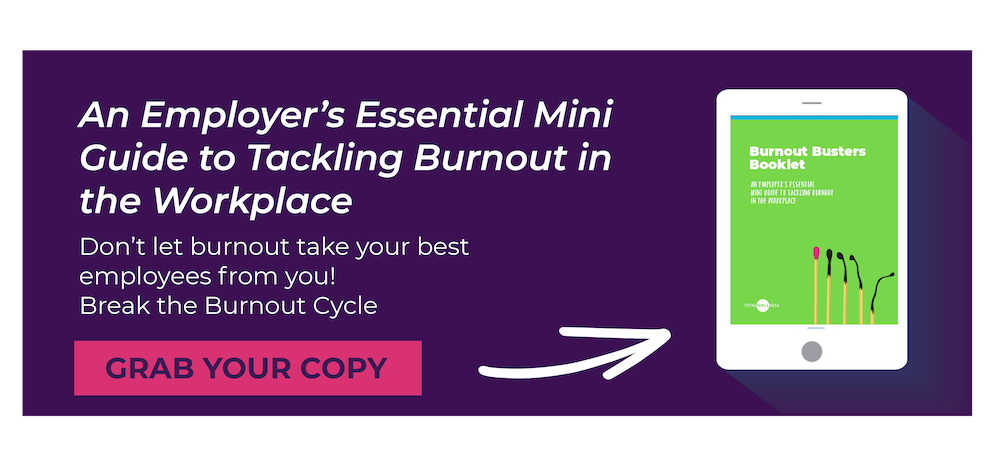 These days, employee burnout is more prevalent than ever thanks to the ongoing stress of the global coronavirus pandemic.
These days, employee burnout is more prevalent than ever thanks to the ongoing stress of the global coronavirus pandemic.
Some U.K. health experts are forecasting a “burnout spike” this January since usual holiday plans — meant to alleviate stress — were disrupted for many.
On top of daily life worries, the pandemic has changed the world as we know it to include new stressors that lead to burnout quicker. That includes the worry of catching the coronavirus, loved ones getting it, and the need to social distance.
Two out of three employees feel more stressed than before the pandemic, according to a recent MetLife Employee Benefit Trends study. With research like that coming out, now is an essential time for employers to look at ways to mitigate the burnout risk.
For proactive employers, there may be a way to stop burnout in its tracks.
Here’s a look at what employee burnout looks like and how to help employees avoid catastrophic burnout.
What is Burnout?
Burnout is the cumulative fallout from excessive and prolonged stress. This happens when employees feel overworked and overwhelmed by the demands of their job. This may happen due to long hours, insufficient staffing, unclear expectations, high demands, and more. The stress levels usually plateau before an employee loses interest and motivation in their work.
The pandemic certainly hasn’t helped burnout risk, either.
The 2020 MetLife Employee Benefit Trends study found pre-COVID that 4 in 10 employees struggled to navigate the demands of today’s flexible, but “always working” workforce mentality. Pre-COVID, that same study found one in three struggling employees took time off, in a 12-month period thanks to stress.
Pandemic restrictions and regulations have only made stress on employees worse.
The hardest hit tends to be working parents who have had to take off work to quarantine, conduct remote school, or care for an elderly parent.
Why Burnout is a Problem
The World Health Organization (WHO) even added burnout to its International Classification of Diseases.
Here's how it’s defined by WHO:
“Burnout is a syndrome conceptualized as resulting from chronic workplace stress that has not been successfully managed. It is characterized by three dimensions: 1) feelings of energy depletion or exhaustion; 2) increased mental distance from one’s job, or feelings of negativism or cynicism related to one's job; and 3) a sense of ineffectiveness and lack of accomplishment.”
Burnout manifests physically and mentally for individuals. It can cause issues ranging from low energy to full on mental breakdowns. Chronic stress can lead to physical issues like headaches and digestive issues. Emotionally, burnout can cause extreme fatigue which limits a person’s ability to get work done, including other life duties.
Burnout is costly for employers, too. Each year, burnout racks up between $125 and $190 billion in healthcare costs. If you’re paying for your employees’ health insurance, or they require time off for doctors’ visits, that’s costing your company, too.
Know the Employee Burnout Signs
Since everyone is different, each person may exhibit different burnout signs. Management in-tune with and regularly connecting with employees will be able to recognize signs of burnout sooner. Additionally, every person’s threshold or reason for burning out is personal, too.
Employees may burnout because they’re:
- Not receiving adequate recognition
- Are working too hard on projects
- Unclear about the goal of the work
- Not feeling supported in the work they do
- Witnessing discrimination or unfair work practices
Personal events can also play a role in burnout as well. While some employers may have an “out of sight, out of mind” philosophy, there’s no denying that employees carry personal baggage into work — even if they don’t talk about it. Health issues, family concerns, perfectionism, and unstable work-life balance can all add to burnout.
Some signs your employees may be burning out:
- Missing deadlines - Are deadlines getting missed a lot? Your employees might be feeling burned out or overwhelmed by the sheer amount of work expected by them.
- Unable to concentrate - For employees on the verge of burnout, it can be difficult to concentrate, even on small tasks. Daydreaming often can also be a sign of burnout.
- Verbal cues - Keep an ear open for employees complaining about workloads, lack of appreciation, and general dissatisfaction. If an employee is also hesitant to take on more work, they may be getting close to burnout. Unsatisfied employees are often more open about their feelings, so listen carefully.
- Body language - Continuously seeing employees sitting in meetings with their arms crossed or slumped postures could be an indication of fed-up, worn-out employees.
- Low energy - If they appear much more sluggish and are fueling up on a lot more coffee, it may be a sign of deadline-weary employees. This is especially important to note in large meetings and even one-on-one meetings. Watch body language that could indicate low energy.
Get Ahead of Employee Burnout
Now you may have some employees in mind who fit the bill for heading straight down burnout road. Luckily, there are some strategies that can be implemented to help them avoid burning out in a significant way.
Here are some ideas to minimize risk of employee burnout:
Educate Your Staff
As with many health topics, there are always plenty of resources to share to prevent burnout in your company. Give your employees access to these resources. They may not know where to find them or have the energy (another hint they really need them!) to search for the help they need. A few ways to educate:
- Books - If you or another leader in your management structure has recently read a good book on burnout or self-care, share it with your staffers. Burnout: Solve Your Stress Cycle by Emily and Amelia Nagoski is one such book worth reading.
- Podcasts - Check out podcasts that focus on positivity, self-care, and happiness. Or ask your employees what podcast they’re listening to and encourage them to do so on a daily basis and chat with them about it. Some podcasts to have your employees consider checking out include Happiness Spells and Happier.
- In-house resources - Last, but not least, remind your employees of what they have in front of them. That can be the quarterly team-building gatherings, the free life coach on staff, the counseling benefits, gym memberships, etc. that your company offers. Remind them of the wealth of resources at their fingertips.
Since it’s not simple to spot burnout easily, it’s important to educate employees themselves on what to be on the lookout for. This goes for department heads, too. Once they have an idea of what to look for, they can pass along suggestions for improvement to leadership on ways to keep employees from burning out.
Minimize Deadline Pressures
If deadlines are swallowing your employees whole, it may be time to figure out a new system to alleviate the pressure. Check-in at key timeline milestones to see how it’s going. If it’s clear there’s a lot of overwhelm, consider setting up a new deadline structure or adding a new team player to help projects get done on time.
Encourage Balance
Work-life balance is hard. The best way to help your employees invest in their well-being is to show them how to do it. When leadership models balance, it makes it easier for workers to follow in their footsteps. Offer flexible working policies, but also provide support by offering balance through other key wellness areas like mental health and financial wellness.
Encourage balance by:
- Mandating paid time off
- Offering flexible work hours
- Providing remote work options
- Hosting a variety of wellness workshops
- Investing in their financial well-being
- Sharing community volunteering opportunities
Consider ways you can provide your team with more work-life balance. This can help them create their ideal schedule, work flow, and workplace opportunities.
Reach Out
Make sure your team leads are connecting with your employees. If employees feel they have a partner in their manager who understands what’s going on when it comes to the day-to-day operations, they’ll be more apt to opening up about burnout risk factors.
When reaching out:
- Actively listen
- Offer compassion
- Provide a solution
- Try a digital employee suggestion box
- Ask how they can feel better supported
Sometimes reaching out one-on-one can cause individuals to clam up. Use observational skills, offer anonymous employee surveys, and openly share about burnout to help employees feel more comfortable discussing it.
Share Productivity Apps and Software
Often, workers just don’t know how to properly manage their time. This can lead to a constant sense of overwhelm and disorganization, which in turn causes missed deadlines and may lead to burnout. If they’ve been given more work duties or a special new project, give them the appropriate resources right along with the new responsibilities. You may pass along suggestions or introduce productivity and time management tools like Toggl, Clockify, Trello, and Asana.
Offer Wellness Resources and Events
Wellness resources are a prime way to help your employees focus on health. That doesn’t mean offering just a free gym membership, either. Look at ways you can provide unique resources covering everything from nutrition and fitness to financial well-being and emotional wellness. When all areas of wellness are balanced, burnout is less likely.
Resources that may be helpful include:
- A digital wellness library
- Hosting a self-help book club
- Regular lunch and learn events
- A monthly wellness challenge
Ask your employees where they find they’re dealing with gaps in their wellness routines. This can intentionally alert them to areas they need to spend more time on before it leads to burnout.
Give Them Hope
Most importantly, remind your employees burnout is not permanent. This may mean a company provides flexible policies and time off for individuals who need it. By creating policies that allow employees to break out from burnout, it shows support to employees while also indicating and confirming to them that burnout isn’t for forever.
What are some ways your company works to prevent employee burnout? Share in the comments below!



